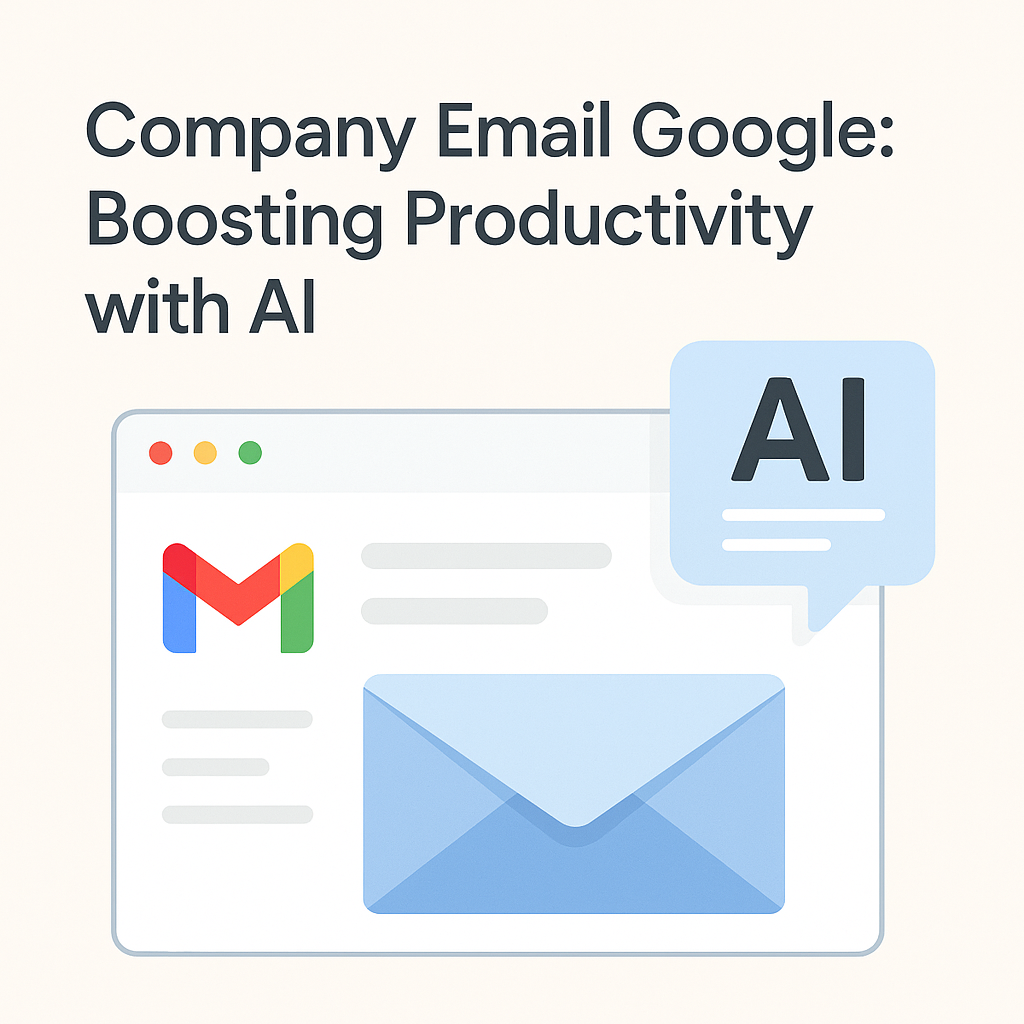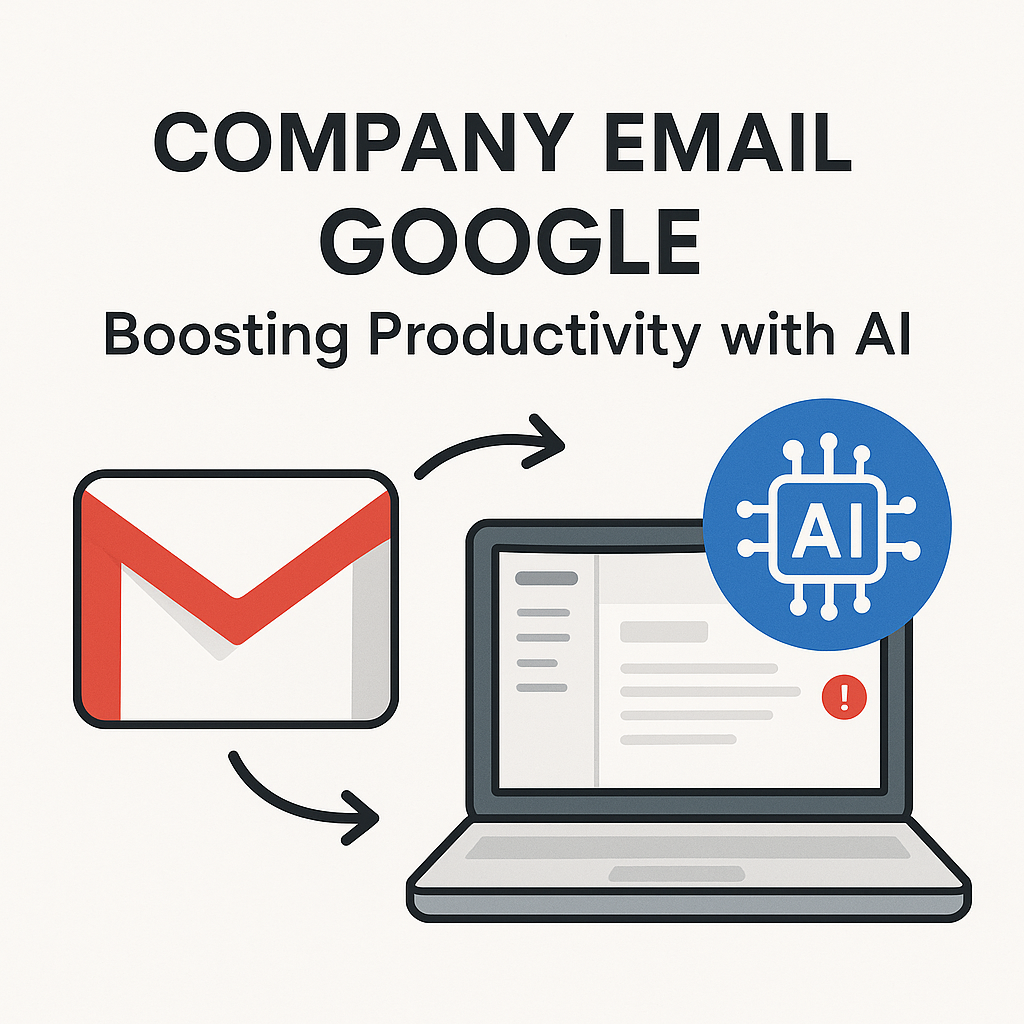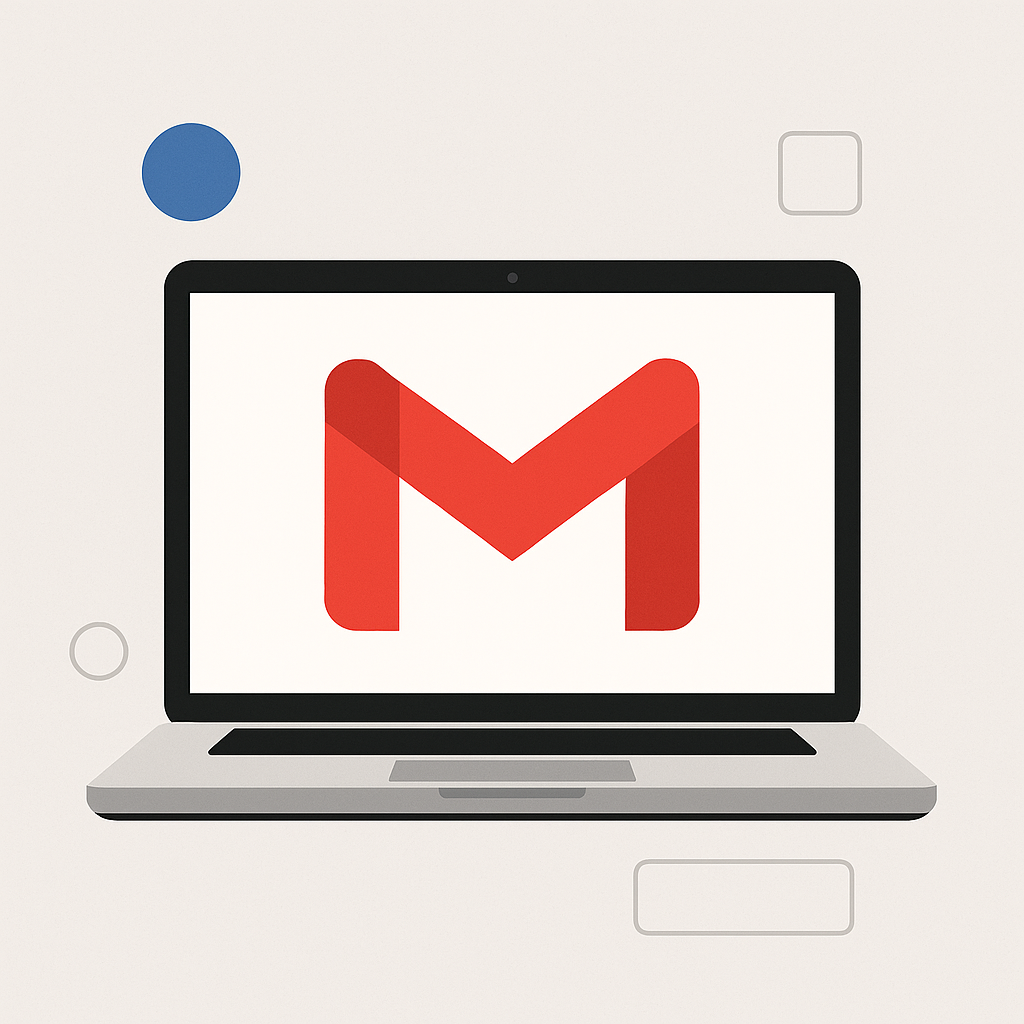Company Email Google: Boosting Productivity with AI

In the fast-paced world of modern business, email remains a cornerstone of communication. However, for many professionals, the inbox has transformed from a helpful tool into a relentless source of stress and lost productivity. We're constantly bombarded with messages, struggling to prioritize, respond, and manage the sheer volume. While platforms like Google's email service for business have long been the standard, the emergence of artificial intelligence is ushering in a new era of email management. This article dives into the capabilities of company email Google offers, explores its limitations for maximizing productivity, and contrasts it with how advanced AI solutions can revolutionize your workflow.
The Evolution of Business Email and the Need for Productivity
Email has come a long way. From simple text-based messages, it has evolved into a rich, multimedia platform integral to sales, marketing, customer service, project management, and internal collaboration. For businesses, a professional email address, often synonymous with services like Google Workspace, is crucial for brand identity and credibility. It's the digital handshake, the primary channel for client interaction, and the repository for vital information.
Yet, this ubiquity comes at a cost. The average business professional receives over 120 emails per day and spends a significant portion of their workday managing them. This constant juggling act leads to:
- Inbox Overload: Feeling overwhelmed by the sheer volume of messages.
- Prioritization Paralysis: Difficulty distinguishing urgent and important emails from less critical ones.
- Time Drain: Hours spent sorting, filing, searching, and drafting routine responses.
- Missed Opportunities: Important leads or action items getting lost in the clutter.
- Context Switching Fatigue: Frequent interruptions that break focus and reduce deep work time.
These challenges highlight a critical need for more intelligent, proactive email management strategies. Simply having a reliable email service isn't enough; businesses need tools that actively help users conquer their inboxes and reclaim their time. This is where AI-powered solutions are making a significant impact, offering a leap forward in efficiency and productivity.
Understanding Google's Email Platform for Business: Features and Limitations
When businesses think of professional email, company email Google, specifically through Google Workspace (formerly G Suite), is often the first solution that comes to mind. Gmail for Business offers a robust suite of features designed for collaboration and communication:
- Custom Domain Email Addresses: Allows you to use your company's domain (e.g., [email protected]), enhancing professionalism. Google Workspace plans facilitate this, unlike free Gmail accounts.
- Robust Search Capabilities: Gmail's powerful search engine allows users to quickly find specific emails, even within vast archives. Google has even integrated AI to enhance search results, surfacing relevant emails faster and boosting productivity.
- Collaboration Tools: Seamless integration with Google Drive, Calendar, Meet, and Docs fosters a connected workflow.
- Security Features: Offers enterprise-grade security, including advanced threat protection, spam filtering, and data loss prevention.
- Mobile Accessibility: Access your inbox from any device, anytime, anywhere.
- Customization: Features like custom layout templates allow for personalization of the user experience.
While these features are powerful and have made Google Workspace a dominant force, from a productivity standpoint, its core email management capabilities are largely based on manual organization and filtering. Users still rely heavily on:
- Creating and managing labels and folders.
- Manually applying filters for incoming mail.
- Starring or flagging emails for follow-up.
- Using basic templates or "Smart Compose" for drafting replies.
While effective for many, these methods require consistent user input and can become cumbersome with high email volumes. The system doesn't proactively identify urgent tasks, summarize lengthy threads, or automatically categorize emails based on nuanced context without explicit user setup. For those seeking deeper gmail for business productivity enhancements, the reliance on manual effort can be a significant bottleneck. Understanding how to organize emails on Gmail effectively is crucial, but even the best manual strategies have their limits.
Key Productivity Challenges Faced by Business Professionals with Standard Email
The limitations of standard email platforms, including the foundational functionalities of company email Google, manifest as tangible productivity challenges for professionals across industries. These aren't minor inconveniences; they represent significant drains on time and focus.
Inbox Overload and Prioritization
The sheer volume of emails received daily is the most common complaint. Without intelligent prioritization, critical messages can be buried under less important ones. This means professionals spend valuable minutes (or even hours) each day sifting through their inbox, trying to determine what needs immediate attention. This constant "search and sort" activity is a major contributor to the feeling of being perpetually behind.
Inefficient Workflow and Time Management
Standard email clients offer basic tools for managing workflow, such as flags and to-do lists. However, they lack the intelligence to:
- Automatically identify action items: Users must manually note tasks mentioned in emails or remember to follow up.
- Prioritize tasks based on urgency or sender importance: The system doesn't inherently know that an email from a key client or a time-sensitive request takes precedence.
- Streamline follow-ups: Reminders are often manual, leading to missed deadlines or follow-up opportunities.
This results in inefficient email workflow optimization, where tasks are managed reactively rather than proactively.
Information Fragmentation and Context Loss
Long email threads can become difficult to follow, especially when multiple people are involved or the topic evolves. Key decisions, action items, or important pieces of information can get lost within the chain. This fragmentation makes it hard to quickly grasp the context of a conversation or retrieve specific details without rereading multiple messages.
Repetitive Tasks and Response Time
Many professionals spend a considerable amount of time drafting similar responses to common inquiries. While features like canned responses or Smart Compose offer some help, they don't provide the sophisticated, context-aware assistance needed to significantly reduce response times for complex queries. This impacts customer service, sales response rates, and overall team efficiency.
These persistent challenges underscore why businesses are actively seeking advanced business email solutions and better inbox management strategies. The current landscape demands tools that go beyond basic organization and communication.
How AI is Revolutionizing Email Management: An Overview
Artificial Intelligence (AI) is no longer a futuristic concept; it's actively reshaping how we interact with our digital tools, and email management is a prime beneficiary. AI-powered email solutions leverage machine learning algorithms to understand, categorize, prioritize, and even respond to emails with unprecedented efficiency.
The core promise of ai email management is to transform the inbox from a passive receptacle into an active, intelligent assistant. Here's how AI is making a difference:
- Intelligent Prioritization: AI can analyze sender, keywords, sentiment, and historical interaction data to assign an urgency score to incoming emails, ensuring critical messages are surfaced immediately.
- Automated Categorization and Filing: Instead of manual sorting, AI can automatically categorize emails (e.g., invoices, meeting requests, support tickets, project updates) and file them into appropriate folders or labels.
- Smart Summarization: AI can condense long email threads or lengthy documents attached to emails into concise summaries, allowing professionals to grasp key information quickly.
- Proactive Task Identification: AI can scan emails to identify potential action items, deadlines, and requests, then prompt users to create tasks or schedule reminders.
- AI-Assisted Responses: Beyond simple suggestions, AI can draft contextually relevant replies, saving significant time on communication.
- Sentiment Analysis: Understanding the tone of an email can help professionals gauge customer satisfaction, manage client relationships, and tailor their responses more effectively.
By automating these time-consuming processes, AI frees up professionals to focus on strategic thinking, creative problem-solving, and high-value interactions. Google itself is investing heavily in AI for its products, with initiatives like upgrades to Gmail search with smarter AI to boost productivity. However, specialized AI tools offer a deeper level of automation and intelligence specifically tailored for advanced email management.
Exploring these advanced tools is key for anyone looking to improve their email productivity tools comparison and find solutions that truly tackle inbox chaos. Tools like an ai executive assistant can help streamline your workflow by handling many of these complex tasks automatically.
MailToPie vs. Google Email: A Feature-by-Feature Productivity Comparison
While Google Workspace provides a solid foundation for business email, specialized AI-powered platforms like MailToPie offer distinct advantages in maximizing productivity. Let's compare their approaches to core email management functions.
Email Prioritization
- Google Email: Relies on user-defined labels, stars, and search filters. While effective for manual organization, it requires constant user intervention to maintain an accurate view of priority.
- MailToPie: Employs AI to automatically analyze and score emails based on urgency, sender importance, keywords, and context. This intelligent prioritization ensures that the most critical messages are always at the forefront, reducing the chance of missed deadlines or urgent communications.
Email Organization and Filing
- Google Email: Primarily uses folders and labels, which are manually applied. While powerful, it can become cumbersome to manage a large number of labels and consistently file emails correctly. Tools such as smart triage and prioritization can help, but the core system remains manual.
- MailToPie: Features AI-driven auto-filing and smart categorization. The system learns your preferences and automatically sorts incoming mail into relevant categories (e.g., projects, clients, invoices, newsletters), keeping your inbox clean and organized without manual effort. It also offers AI-powered summaries of long threads, making information retrieval much faster.
Response Drafting and Assistance
- Google Email: Offers "Smart Compose" for suggesting word completions and "canned responses" for pre-written templates. These are helpful but limited in scope and personalization.
- MailToPie: Provides AI-generated draft replies that are context-aware and tailored to the specific email. This significantly reduces the time spent composing responses, especially for common inquiries or complex follow-ups, thereby enhancing email workflow optimization.
Task Management and Follow-ups
- Google Email: Integrates with Google Tasks, allowing users to manually create tasks from emails. Follow-up reminders are also often set manually.
- MailToPie: AI scans emails to automatically identify action items, deadlines, and potential follow-up opportunities. It can proactively create tasks, set reminders, and even suggest when to follow up based on the email's content and context, acting as a powerful AI productivity assistant.
Information Retrieval
- Google Email: Leverages robust search functionality.
- MailToPie: Combines powerful search with AI-powered summarization and contextual understanding. This means you can not only find emails but also quickly get the gist of a conversation or extract specific information without reading through entire threads.
In essence, while Google provides a reliable and feature-rich email platform, AI-enhanced solutions like MailToPie elevate email management from a manual chore to an intelligent, automated process. This shift is crucial for professionals aiming for peak gmail for business productivity.
Specific Use Cases: Enhancing Workflow for Executives, Entrepreneurs, and Sales Teams
The impact of AI-powered email management is particularly profound for professionals who handle high volumes of communication and whose success hinges on efficient follow-up and organization.
For Executives: Strategic Communication and Time Reclamation
Executives are often drowning in emails from direct reports, stakeholders, clients, and industry news. AI can:
- Provide Executive Summaries: AI can summarize lengthy email chains or reports, allowing executives to grasp key information quickly without reading every word.
- Flag Urgent Matters: Automatically identify and prioritize communications that require immediate executive attention, such as critical client issues or urgent board requests.
- Streamline Delegation: AI can help identify tasks that can be delegated and even draft initial delegation messages to team members.
- Manage External Communications: Ensure important client and partner communications are responded to promptly, maintaining strong relationships.
This focus on intelligent filtering and summarization directly contributes to better email workflow optimization for top-level decision-makers.
For Entrepreneurs: Juggling Roles and Maximizing Opportunities
Entrepreneurs wear many hats, from sales and marketing to customer service and operations. Their inbox is often the central hub for all these activities.
- Lead Management: AI can help identify and tag potential leads from incoming emails, track follow-ups, and ensure no sales opportunity slips through the cracks. This ties directly into growing business with AI email revenue.
- Customer Service Efficiency: Automatically categorize support requests, draft initial responses, and ensure timely resolution, improving customer satisfaction.
- Time-Saving Automation: By automating routine tasks like filing invoices, scheduling meetings, and responding to FAQs, entrepreneurs can dedicate more time to strategic growth and business development.
For entrepreneurs, an AI assistant is not just a convenience but a necessity to manage diverse responsibilities effectively.
For Sales Teams: Pipeline Management and Client Engagement
Sales professionals rely heavily on email for prospecting, nurturing leads, closing deals, and managing client relationships. AI can significantly enhance their performance:
- Automated Follow-ups: Ensure timely follow-ups on leads and proposals, increasing conversion rates.
- Contact and Deal Tracking: Extract contact information and details about deals from emails, automatically updating CRM systems or creating task lists.
- Client Sentiment Analysis: Gauge the tone of client communications to understand their needs and adjust sales strategies accordingly.
- Competitor Intelligence: By analyzing incoming communications and understanding communication patterns, businesses can gain insights into market trends and competitor activities, contributing to competitor email analysis.
By streamlining these processes, sales teams can spend more time selling and less time on administrative email tasks.
For all these roles, leveraging advanced ai email management tools is key to overcoming the limitations of traditional email systems and achieving higher levels of productivity.
Security and Integration: What to Consider Beyond Core Features
When choosing a business email solution, core productivity features are paramount, but security and integration capabilities are equally critical for long-term success and operational efficiency.
Enterprise Email Security
Security is non-negotiable for any business. Both Google Workspace and advanced AI platforms must meet stringent security standards.
- Google Workspace: Offers robust, multi-layered security, including AI-powered threat detection, phishing protection, spam filtering, and encryption. Its infrastructure is designed for high security and compliance.
- AI Email Management Tools: Reputable AI platforms prioritize data security and privacy. They often leverage secure cloud infrastructure and implement advanced encryption protocols for data in transit and at rest. It's essential to ensure the AI tool complies with relevant data protection regulations (like GDPR or CCPA) and has clear policies on how your data is used to train its AI models. Look for solutions that offer strong secure email for business practices.
Understanding your specific security needs, such as compliance requirements and data handling policies, is vital when comparing options.
Integration Capabilities
Your email system doesn't operate in a vacuum. Its ability to integrate with other essential business tools can dramatically amplify its value.
- Google Workspace: Excels in its native integration with other Google products like Google Drive, Calendar, and Meet, creating a cohesive ecosystem.
- AI Email Management Tools: Advanced AI solutions often offer broad integration capabilities with third-party applications such as CRMs (Salesforce, HubSpot), project management tools (Asana, Trello), communication platforms (Slack), and more. This allows for seamless data flow, automation across platforms, and a unified view of business operations. For instance, integrating an AI email assistant with your CRM can automate lead updates and client communication tracking.
The choice between a tightly integrated suite like Google Workspace and a specialized AI tool that integrates broadly depends on your existing tech stack and specific workflow needs. However, the trend is towards AI tools that can enhance, rather than replace, existing infrastructure by providing intelligent layers on top.
Furthermore, considering the underlying infrastructure is important. Secure mail hosting is the backbone that supports reliable and safe email delivery and management, especially when AI features are involved.
Conclusion: Choosing the Right Email Solution for Maximum Business Productivity
The journey from basic email communication to sophisticated, AI-driven workflow optimization is a critical evolution for modern businesses. While company email Google (Gmail for Business) provides a robust, secure, and collaborative platform that has served as the standard for years, its inherent reliance on manual organization and prioritization can be a bottleneck in today's high-volume communication environment.
The challenges of inbox overload, inefficient workflows, and the constant struggle to prioritize are not merely inconveniences; they are direct detractors from productivity, creativity, and strategic focus. As we've explored, AI is revolutionizing ai email management by offering intelligent automation, proactive task identification, smart summarization, and context-aware response assistance.
When you conduct an email productivity tools comparison, the distinction becomes clear: standard platforms offer the infrastructure, while AI-powered solutions offer the intelligence and automation needed to truly conquer your inbox. Tools like an ai executive assistant are designed to augment your existing email capabilities, transforming how you interact with your communications and significantly boosting your daily output.
For executives, entrepreneurs, sales professionals, and anyone feeling overwhelmed by their inbox, investing in advanced AI email management is no longer a luxury—it's a strategic imperative. It's about reclaiming your time, enhancing your focus, and ensuring that your email communication serves as a powerful asset, rather than a productivity drain.
Is your current email system truly serving your productivity goals? Explore how AI can help you achieve peak efficiency and transform your inbox into a streamlined command center. Take the first step towards smarter email management today.
```


